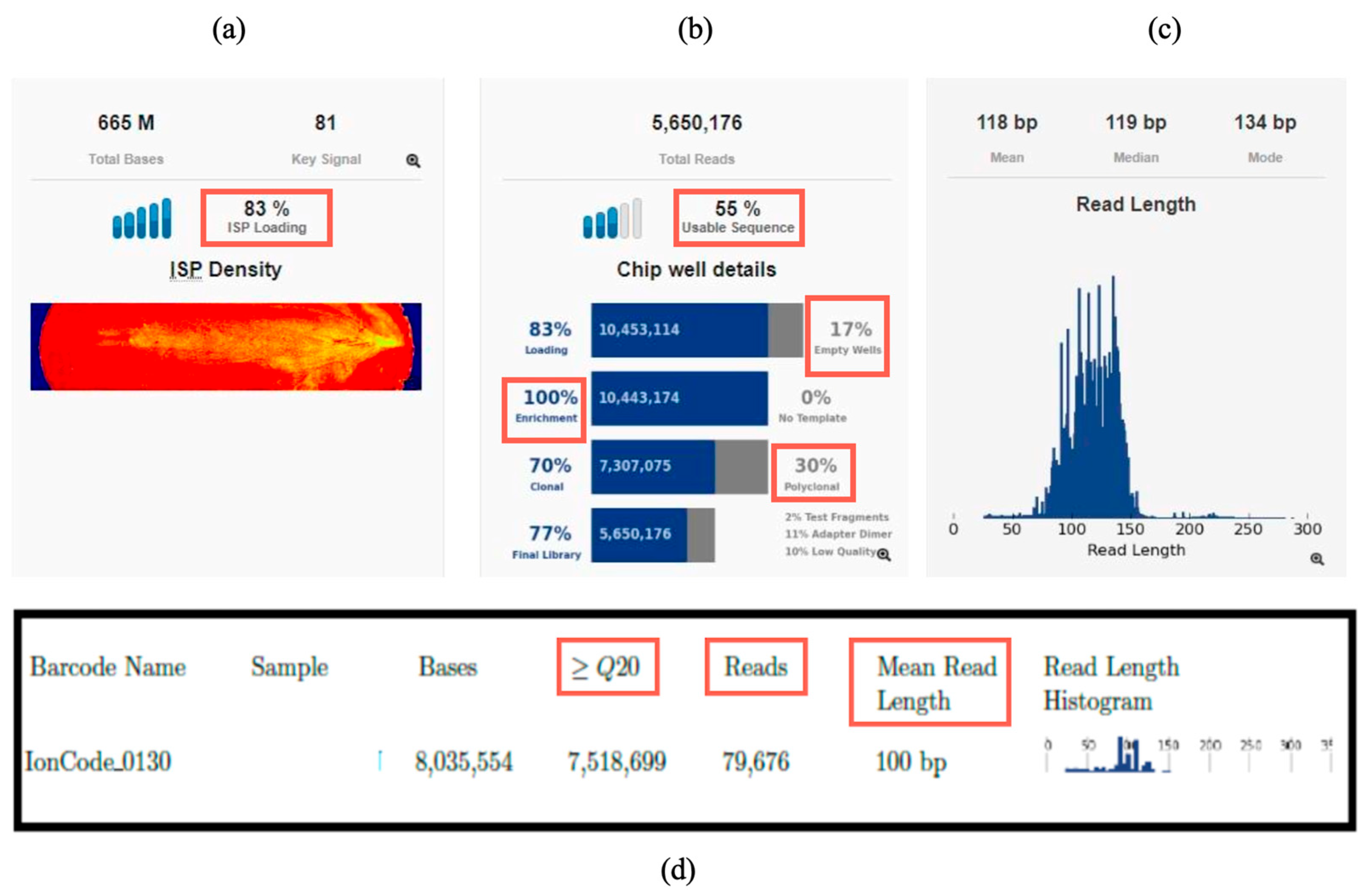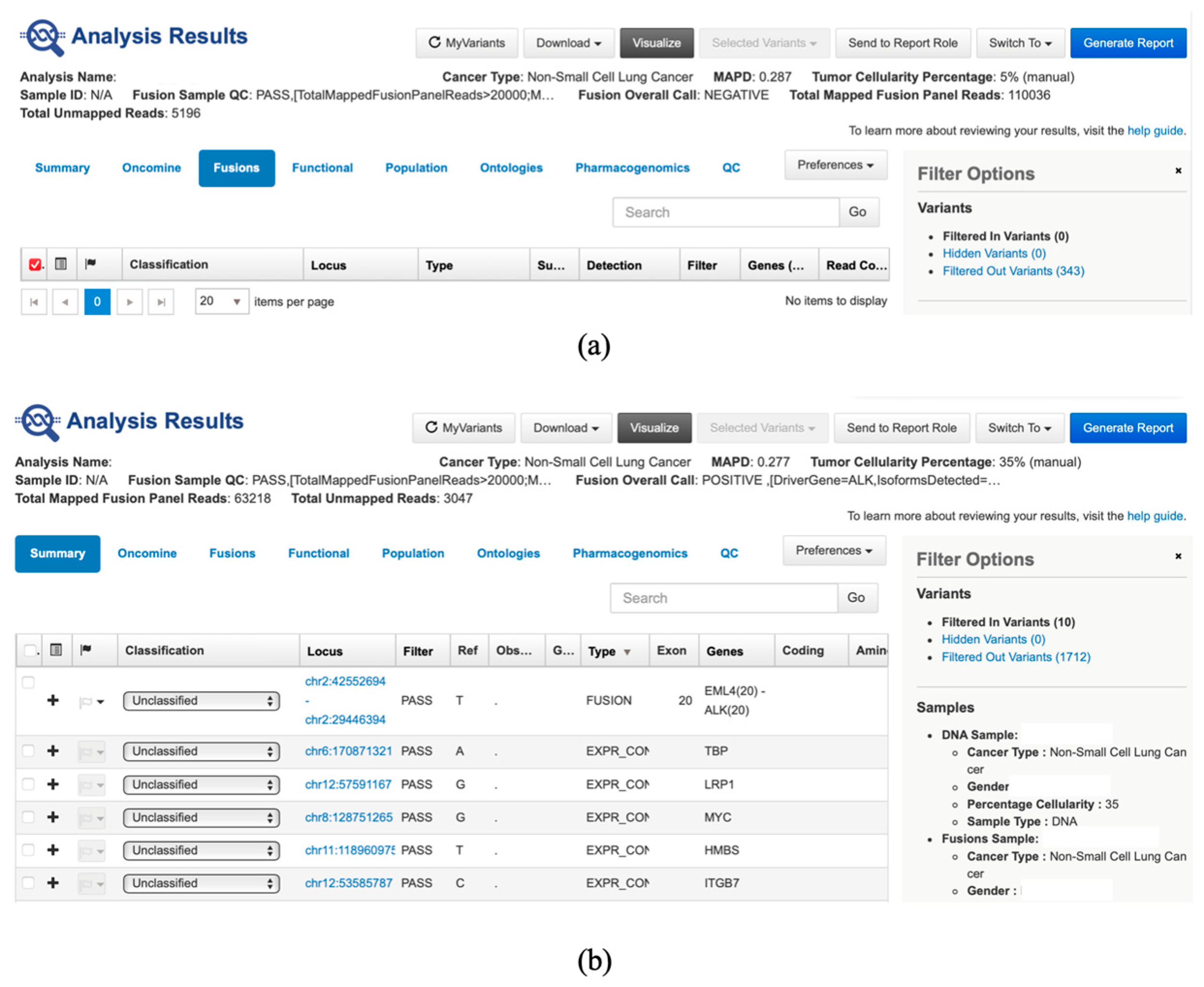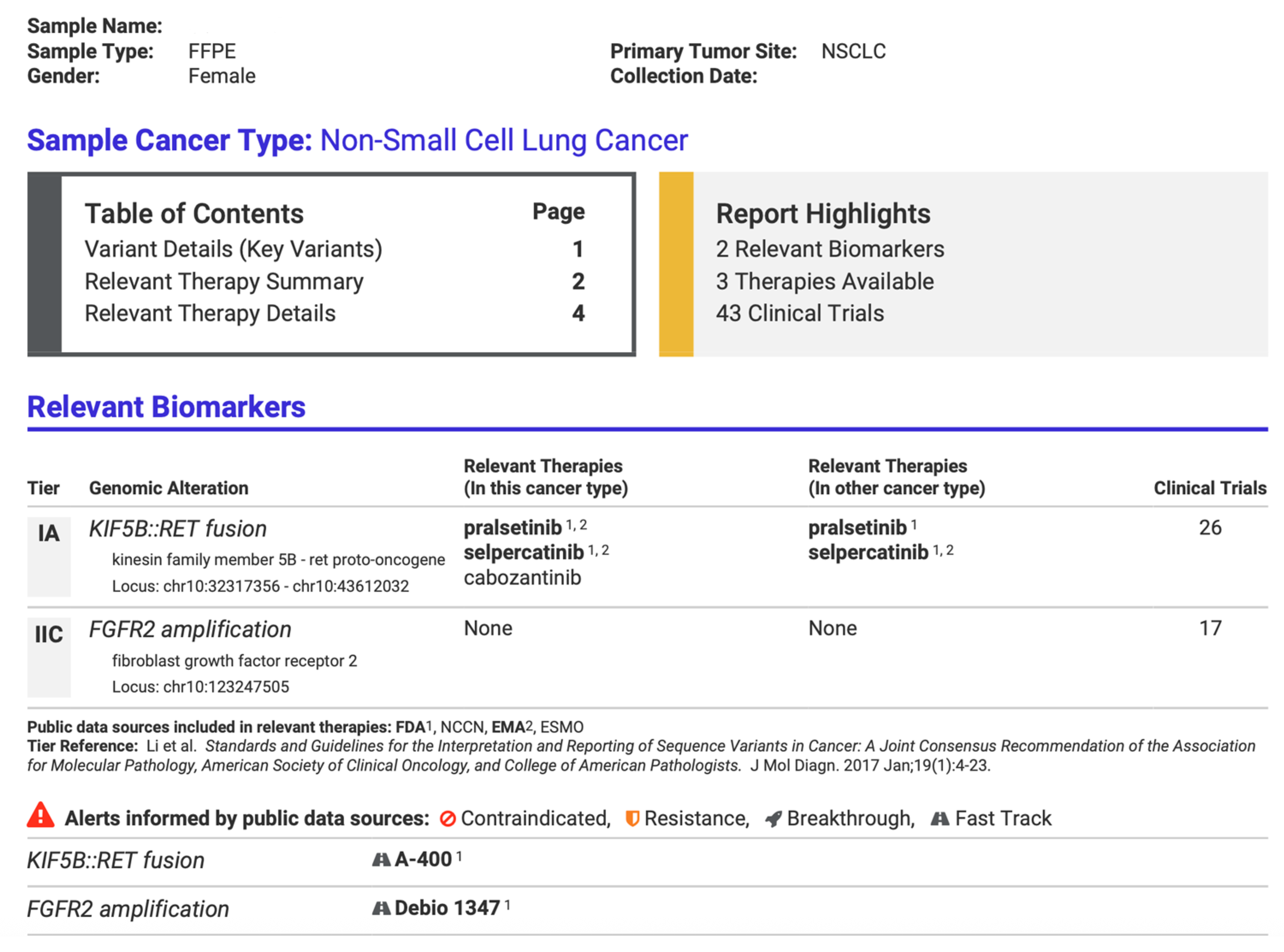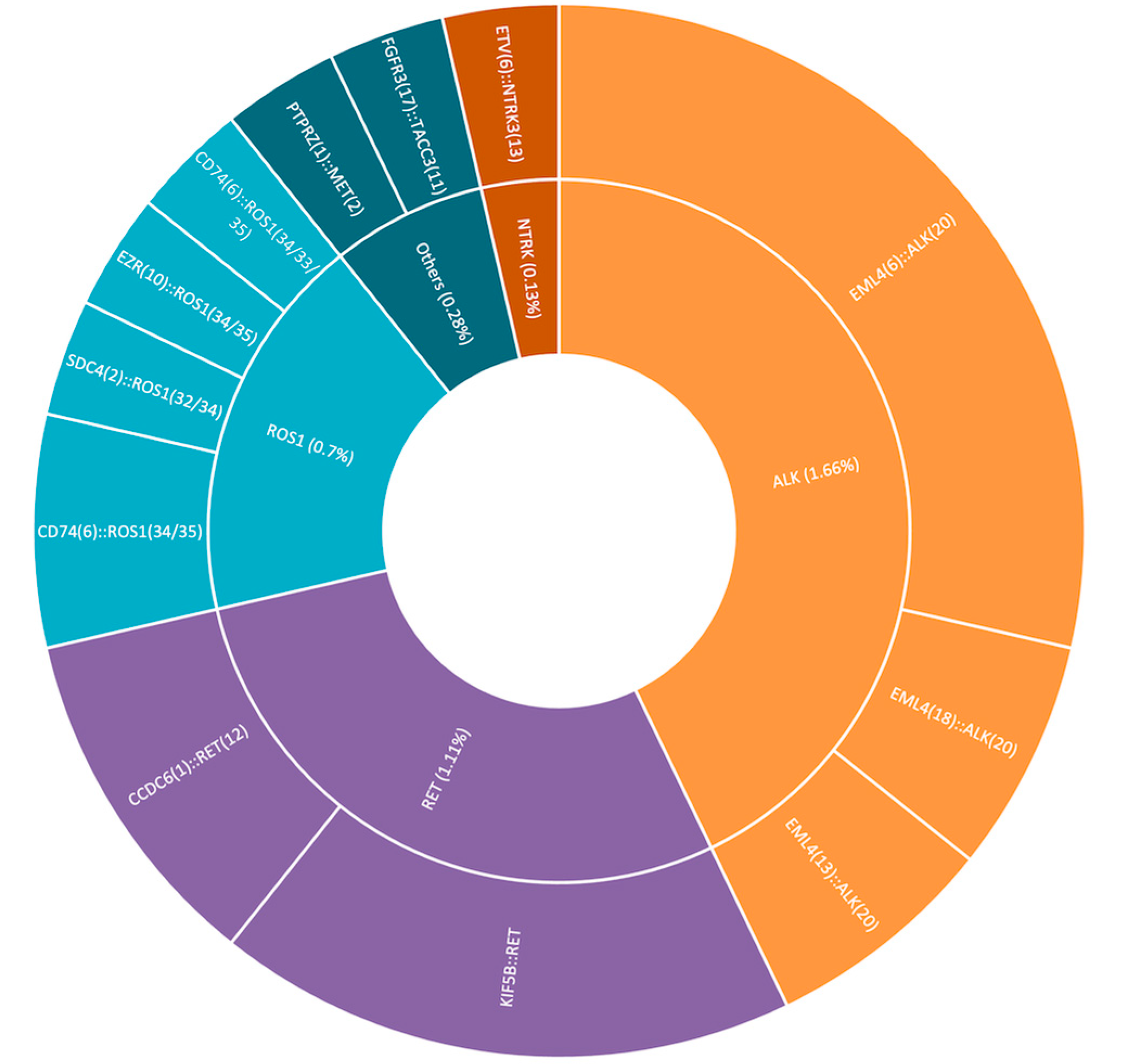Comprehensive Molecular Diagnostic Tests in Non-Small Cell Lung Cancer: Frequency of ALK, ROS1, RET, and Other Gene Fusions/Rearrangements in a Romanian Cohort
Simple Summary
Abstract
1. Introduction
2. Materials and Methods
2.1. Patient Sampling
2.2. DNA and RNA Purification for NGS Testing
2.3. NGS Using Ion Torrent Technology
2.3.1. QC Metrics
2.3.2. Data Analysis
2.3.3. Variant Annotation and Results Reporting
3. Results
4. Discussion
5. Conclusions
Author Contributions
Funding
Institutional Review Board Statement
Informed Consent Statement
Data Availability Statement
Conflicts of Interest
References
- Ancusa, V.M.; Trusculescu, A.A.; Constantinescu, A.; Burducescu, A.; Fira-Mladinescu, O.; Manolescu, D.L.; Traila, D.; Wellmann, N.; Oancea, C.I. Temporal Trends and Patient Stratification in Lung Cancer: A Comprehensive Clustering Analysis from Timis County, Romania. Cancers 2025, 17, 2305. [Google Scholar] [CrossRef]
- Muminovic, M.; Carracedo Uribe, C.R.; Alvarez-Pinzon, A.; Shan, K.; Raez, L.E. Importance of ROS1 gene fusions in non-small cell lung cancer. Cancer Drug Resist. 2023, 6, 332–344. [Google Scholar] [CrossRef]
- Theik, N.W.Y.; De Armas, S.A.; Rosas, D.; Kiamos, A.; Thaw Dar, N.N.; Shoreibah, A.; Hussein, A.; Raez, L.E. Oncogenic Fusions in NSCLC: From Mechanisms to Clinical Applications. Int. J. Mol. Sci. 2025, 26, 3802. [Google Scholar] [CrossRef]
- Suda, K.; Mitsudomi, T. Emerging oncogenic fusions other than ALK, ROS1, RET, and NTRK in NSCLC and the role of fusions as resistance mechanisms to targeted therapy. Transl. Lung Cancer Res. 2020, 9, 2618–2628. [Google Scholar] [CrossRef]
- Hu, X.; Wang, Q.; Tang, M.; Barthel, F.; Amin, S.; Yoshihara, K.; Lang, F.M.; Martinez-Ledesma, E.; Lee, S.H.; Zheng, S.; et al. TumorFusions: An integrative resource for cancer-associated transcript fusions. Nucleic Acids Res. 2018, 46, D1144–D1149. [Google Scholar] [CrossRef]
- Gao, Q.; Liang, W.W.; Foltz, S.M.; Mutharasu, G.; Jayasinghe, R.G.; Cao, S.; Liao, W.W.; Reynolds, S.M.; Wyczalkowski, M.A.; Yao, L.; et al. Driver Fusions and Their Implications in the Development and Treatment of Human Cancers. Cell Rep. 2018, 23, 227–238.e3. [Google Scholar] [CrossRef] [PubMed]
- Chen, J.; Xu, C.; Lv, J.; Lu, W.; Zhang, Y.; Wang, D.; Song, Y. Clinical characteristics and targeted therapy of different gene fusions in non-small cell lung cancer: A narrative review. Transl. Lung Cancer Res. 2023, 12, 895–908. [Google Scholar] [CrossRef]
- NCCN. Clinical Practice Guidelines in Oncology. In Non-Small Cell Lung Cancer, Version 8.2025; NCCN: Plymouth Meeting, PA, USA, 2025; Available online: https://www.nccn.org/professionals/physician_gls/pdf/nscl.pdf (accessed on 1 October 2025).
- ThermoFisher Scientific. Genexus™ Purification System USER GUIDE; ThermoFisher Scientific: Waltham, MA, USA, 2025; Available online: https://documents.thermofisher.com/TFS-Assets%2FLSG%2Fmanuals%2FMAN0018475_GenexusPurificationSystem_UG.pdf (accessed on 1 October 2025).
- ThermoFisher Scientific. MagMAX™ FFPE DNA/RNA Ultra KIT INSERT; ThermoFisher Scientific: Waltham, MA, USA, 2025; Available online: https://documents.thermofisher.com/TFS-Assets/LSG/manuals/MAN0015877_MagMAX_FFPE_DNA_RNA_Ultra_UG.pdf (accessed on 1 October 2025).
- ThermoFisher Scientific. Ion Chef™ System USER GUIDE; ThermoFisher Scientific: Waltham, MA, USA, 2025; Available online: https://documents.thermofisher.com/TFS-Assets%2FLSG%2Fmanuals%2FMAN0018668_IonChefInstrument_UG.pdf (accessed on 1 October 2025).
- ThermoFisher Scientific. Oncomine Focus Assay KIT INSERT; ThermoFisher Scientific: Waltham, MA, USA, 2025; Available online: https://documents.thermofisher.com/TFS-Assets/LSG/manuals/MAN0015819_Part1_OFAv1S5FTLibraryPrep_UG.pdf (accessed on 1 October 2025).
- Raphael, A.; Dudnik, E.; Hershkovitz, D.; Jain, S.; Olsen, S.; Soussan-Gutman, L.; Ben-Shitrit, T.; Dvir, A.; Nechushtan, H.; Peled, N.; et al. FGFR Fusions as an Acquired Resistance Mechanism Following Treatment with Epidermal Growth Factor Receptor Tyrosine Kinase Inhibitors (EGFR TKIs) and a Suggested Novel Target in Advanced Non-Small Cell Lung Cancer (aNSCLC). J. Clin. Med. 2022, 11, 2475. [Google Scholar] [CrossRef] [PubMed]
- Riedel, R.; Fassunke, J.; Scheel, A.H.; Scheffler, M.; Heydt, C.; Nogova, L.; Michels, S.; Fischer, R.N.; Eisert, A.; Scharpenseel, H.; et al. MET Fusions in NSCLC: Clinicopathologic Features and Response to MET Inhibition. J. Thorac. Oncol. 2024, 19, 160–165. [Google Scholar] [CrossRef] [PubMed]
- Programul Naţional de Oncologie. Available online: https://cnas.ro (accessed on 1 October 2025).
- Lei, Y.; Lei, Y.; Shi, X.; Wang, J. EML4-ALK fusion gene in non-small cell lung cancer. Oncol. Lett. 2022, 24, 277. [Google Scholar] [CrossRef] [PubMed] [PubMed Central]
- Xia, W.; Yang, J.; Li, H.; Li, L.; Liu, J. Comparing Genomic Profiles of ALK Fusion-Positive and ALK Fusion-Negative Nonsmall Cell Lung Cancer Patients. Glob. Med. Genet. 2024, 11, 175–186. [Google Scholar] [CrossRef]
- Gaal, O.I.; Ungureanu, A.; Pop, B.; Tomescu, A.; Cătană, A.; Man, M.; Râjnoveanu, R.M.; Palade, E.; Simon, M.; Luchian, S.D.; et al. The Genomic Landscape of Romanian Non-Small Cell Lung Cancer Patients: The Insights from Routine NGS Testing with the Oncomine Dx Target Panel at the PATHOS Molecular Pathology Laboratory. Cancers 2025, 17, 1947. [Google Scholar] [CrossRef]
- Facchinetti, F.; Gandolfi, L.; Vasseur, D.; Melocchi, L.; Nakazawa, S.; Tiseo, M.; Friboulet, L.; Rossi, G. ALK fusions turn sixteen in lung cancer: A review on their biology, detection and therapy. Precis. Cancer Med. 2024, 6, 2. [Google Scholar] [CrossRef]
- Gendarme, S.; Bylicki, O.; Chouaid, C.; Guisier, F. ROS-1 Fusions in Non-Small-Cell Lung Cancer: Evidence to Date. Curr. Oncol. 2022, 29, 641–658. [Google Scholar] [CrossRef] [PubMed] [PubMed Central]
- Conde, E.; Hernandez, S.; Rodriguez Carrillo, J.L.; Martinez, R.; Alonso, M.; Curto, D.; Jimenez, B.; Caminoa, A.; Benito, A.; Garrido, P.; et al. RET Fusion Testing in Patients with NSCLC: The RETING Study. JTO Clin. Res. Rep. 2024, 5, 100653. [Google Scholar] [CrossRef] [PubMed]
- Tan, A.C.; Seet, A.O.L.; Lai, G.G.Y.; Lim, T.H.; Lim, A.S.T.; Tan, G.S.; Takano, A.; Tai, D.W.M.; Tan, T.J.Y.; Lam, J.Y.C.; et al. Molecular Characterization and Clinical Outcomes in RET-Rearranged NSCLC. J. Thorac. Oncol. 2020, 15, 1928–1934. [Google Scholar] [CrossRef]
- Shen, Z.; Qiu, B.; Li, L.; Yang, B.; Li, G. Targeted therapy of RET fusion-positive non-small cell lung cancer. Front. Oncol. 2022, 12, 1033484. [Google Scholar] [CrossRef]
- Hagopian, G.; Nagasaka, M. Oncogenic fusions: Targeting NTRK. Crit. Rev. Oncol. Hematol. 2024, 194, 104234. [Google Scholar] [CrossRef] [PubMed]
- Gutierrez-Herrera, J.; Montero-Fernandez, M.A.; Kokaraki, G.; De Petris, L.; Maia Falcão, R.; Molina-Centelles, M.; Guijarro, R.; Ekman, S.; Ortiz-Villalón, C. NTRK Gene Expression in Non-Small-Cell Lung Cancer. J. Respir. 2025, 5, 2. [Google Scholar] [CrossRef]
- Dyrbekk, A.P.H.; Warsame, A.A.; Suhrke, P.; Ludahl, M.O.; Zecic, N.; Moe, J.O.; Lund-Iversen, M.; Brustugun, O.T. Evaluation of NTRK expression and fusions in a large cohort of early-stage lung cancer. Clin. Exp. Med. 2024, 24, 10. [Google Scholar] [CrossRef]
- Scharpenseel, H.; Stickelmann, A.; Siemanowski, J.; Malchers, F.; Scheffler, M.; Hillmer, A.; Meemboor, S.; Merkelbach-Bruse, S.; Scheel, S.; Riedel, R.; et al. Clinical characteristics and treatment outcome of patients with advanced non-small-cell lung cancer (NSCLC) and FGFR fusions. J. Clin. Oncol. 2023, 41, e21139. [Google Scholar] [CrossRef]
- Qin, A.; Johnson, A.; Ross, J.S.; Miller, V.A.; Ali, S.M.; Schrock, A.B.; Gadgeel, S.M. Detection of Known and Novel FGFR Fusions in Non-Small Cell Lung Cancer by Comprehensive Genomic Profiling. J. Thorac. Oncol. 2019, 14, 54–62. [Google Scholar] [CrossRef]
- Zhou, Z.; Liu, Z.; Ou, Q.; Wu, X.; Wang, X.; Shao, Y.; Liu, H.; Yang, Y. Targeting FGFR in non-small cell lung cancer: Implications from the landscape of clinically actionable aberrations of FGFR kinases. Cancer Biol. Med. 2021, 18, 490–501. [Google Scholar] [CrossRef]
- Chai, R.C.; Liu, X.; Pang, B.; Liu, Y.Q.; Li, J.J.; Li, Y.F.; Zhao, Z.; Du, J.; Bao, Z.S.; Jiang, T. Recurrent PTPRZ1-MET fusion and a high occurrence rate of MET exon 14 skipping in brain metastases. Cancer Sci. 2022, 113, 796–801. [Google Scholar] [CrossRef] [PubMed]
- Sun, D.; Xing, X.; Wang, Y.; Hou, H. MET fusions are targetable genomic variants in the treatment of advanced malignancies. Cell Commun. Signal. 2024, 22, 20. [Google Scholar] [CrossRef]
- Zhao, Y.; Wang, S.; Yang, Z.; Dong, Y.; Wang, Y.; Zhang, L.; Hu, H.; Han, B. Co-Occurring Potentially Actionable Oncogenic Drivers in Non-Small Cell Lung Cancer. Front. Oncol. 2021, 11, 665484. [Google Scholar] [CrossRef]
- Peng, M.; Deng, J.; Li, X. Clinical advances and challenges in targeting FGF/FGFR signaling in lung cancer. Mol. Cancer 2024, 23, 256. [Google Scholar] [CrossRef] [PubMed]
- Capelletti, M.; Dodge, M.E.; Ercan, D.; Hammerman, P.S.; Park, S.I.; Kim, J.; Sasaki, H.; Jablons, D.M.; Lipson, D.; Young, L.; et al. Identification of recurrent FGFR3-TACC3 fusion oncogenes from lung adenocarcinoma. Clin. Cancer Res. 2014, 20, 6551–6558. [Google Scholar] [CrossRef]
- Pecciarini, L.; Brunetto, E.; Grassini, G.; De Pascali, V.; Ogliari, F.R.; Talarico, A.; Marra, G.; Magliacane, G.; Redegalli, M.; Arrigoni, G.; et al. Gene Fusion Detection in NSCLC Routine Clinical Practice: Targeted-NGS or FISH? Cells 2023, 12, 1135. [Google Scholar] [CrossRef] [PubMed]
- Zhu, Q.; Zhan, P.; Zhang, X.; Lv, T.; Song, Y. Clinicopathologic characteristics of patients with ROS1 fusion gene in non-small cell lung cancer: A meta-analysis. Transl. Lung Cancer Res. 2015, 4, 300–309. [Google Scholar] [CrossRef]
- Kang, J.; Zhang, X.C.; Chen, H.J.; Zhong, W.Z.; Xu, Y.; Su, J.; Zhou, Q.; Tu, H.Y.; Wang, Z.; Xu, C.R.; et al. Complex ALK Fusions Are Associated with Better Prognosis in Advanced Non-Small Cell Lung Cancer. Front. Oncol. 2020, 11, 596937. [Google Scholar] [CrossRef] [PubMed]




| Hotspot Genes | Copy Number Variation (CNV) Genes | Fusion Genes |
|---|---|---|
| AKT1, FGFR2/3, MET, ALK, GNA11, MTOR, AR, GNAQ, NRAS, BRAF, HRAS, PDGFRA, CDK4, IDH1/2, PIK3CA, CTNNB1, RAF1, DDR2, JAK1/2/3, RET, EGFR, ROS1, ERBB2/3/4, SMO, KIT, KRAS, ESR1, MAP2K1/K2 | ALK, KRAS, AR, MET, BRAF, MYC, CCND1, MYCN, CDK4/6, PDGFRA, PIK3CA, EGFR, ERBB2, FGFR1/2/3/4, KIT | ABL1, FGFR1/2/3, ALK, AKT3, MET, AXL, NTRK1/2/3, BRAF, EGFR, ERBB2, PDGFRA, ERG, PPARG, ETV1/4/5, RAF1, RET, ROS1 |
| EML4-ALK | ROS1 | ||
| EML4(6)::ALK(20) | 8 | CD74(6)::ROS1(34) + CD74(6)::ROS1(35) | 2 |
| EML4(13)::ALK(20) | 2 | CD74(6)::ROS1(34) + CD74(6)::ROS1(33) + CD74(6):ROS1(35) | 1 |
| EML4(18)::ALK(20) | 2 | CD74(6)::ROS1(34) + CD74(6)::ROS1(33) + CD74(6):ROS1(35) | 1 |
| SDC4(2)::ROS1(32) + SDC4(2)::ROS1(34) | 1 | ||
| RET | Others | ||
| KIF5B::RET | 5 | FGFR3(17)::TACC3(11) | 1 |
| CCDC6(1)::RET(12) | 3 | PTPRZ(1)::MET(2) | 1 |
| ETV(6)::NTRK3(11) | 1 | ||
| Parameters | Number of Patients (Total = 28) |
|---|---|
| Sex—n (%) | |
| Male | 15 (53.57%) |
| Female | 13 (46.42%) |
| Age-mean (±SD)—n = 28 | |
| 30–45 | 3 |
| 46–60 | 5 |
| 61–75 | 14 |
| >75 | 6 |
| Smoking status—n (%) | |
| Never smoker | 28 (100%) |
| EGFR status—n (%) | |
| Negative (Wild-Type) | 27 (99%) |
| Positive | 1 (1%)—L858R (co-occurring with FGFR3::TACC3 fusio) |
Disclaimer/Publisher’s Note: The statements, opinions and data contained in all publications are solely those of the individual author(s) and contributor(s) and not of MDPI and/or the editor(s). MDPI and/or the editor(s) disclaim responsibility for any injury to people or property resulting from any ideas, methods, instructions or products referred to in the content. |
© 2025 by the authors. Licensee MDPI, Basel, Switzerland. This article is an open access article distributed under the terms and conditions of the Creative Commons Attribution (CC BY) license (https://creativecommons.org/licenses/by/4.0/).
Share and Cite
Cohn, E.-A.; Tataru, E.; Csutak, O. Comprehensive Molecular Diagnostic Tests in Non-Small Cell Lung Cancer: Frequency of ALK, ROS1, RET, and Other Gene Fusions/Rearrangements in a Romanian Cohort. Cancers 2025, 17, 3673. https://doi.org/10.3390/cancers17223673
Cohn E-A, Tataru E, Csutak O. Comprehensive Molecular Diagnostic Tests in Non-Small Cell Lung Cancer: Frequency of ALK, ROS1, RET, and Other Gene Fusions/Rearrangements in a Romanian Cohort. Cancers. 2025; 17(22):3673. https://doi.org/10.3390/cancers17223673
Chicago/Turabian StyleCohn (Vizitiu), Ester-Andreea, Ecaterina Tataru, and Ortansa Csutak. 2025. "Comprehensive Molecular Diagnostic Tests in Non-Small Cell Lung Cancer: Frequency of ALK, ROS1, RET, and Other Gene Fusions/Rearrangements in a Romanian Cohort" Cancers 17, no. 22: 3673. https://doi.org/10.3390/cancers17223673
APA StyleCohn, E.-A., Tataru, E., & Csutak, O. (2025). Comprehensive Molecular Diagnostic Tests in Non-Small Cell Lung Cancer: Frequency of ALK, ROS1, RET, and Other Gene Fusions/Rearrangements in a Romanian Cohort. Cancers, 17(22), 3673. https://doi.org/10.3390/cancers17223673





